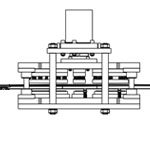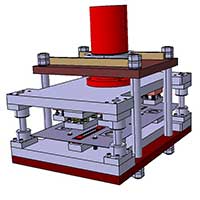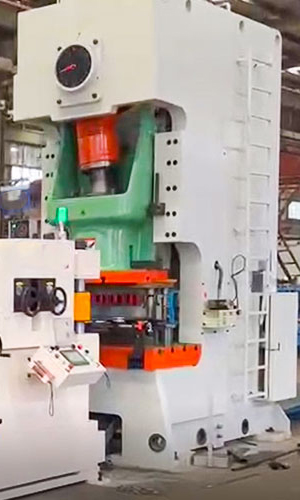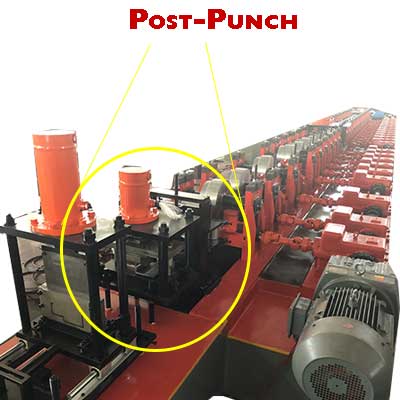Press Punching In Roll Forming Line
- Home
- Press Punching In Roll Forming Line
Press & Punching System in roll forming machine
Press Punching In Roll Forming Line: Roll forming a metal fabrication process that involves the bending of metal strips to create a specified shape or design. however, there are several components that Let in this happen.
it’s necessary, You should know exactly how your roll formed part is made.
A punch press is a type of machine that makes cut holes in the sheet material.
the punching systems in the roll forming machine specially design into the sheet metal, suit to the budget amount and the speed required.
A press machine is any device that uses pressure to make or change metal materials. Roll Forming Services with Pre-Notching, Pre-Punching.These roll forming operations are all done Inline with presses during the production of the Roll Formed Sections on a roll forming machine.


Pre Punch vs post punch in roll forming machine
In roll forming machines, pre-punch and post-punch refer to the stages at which holes, notches, or other features are added to the material, usually metal.
Pre-Punch roll forming machine :
- Location: The decoiler (where the raw material is unwound) and the entry side of the roll forming machine.
- Function: This involves punching or cutting the material before the roll forming process.
- Advantages:
- Provides more control over the placement and alignment of holes, notches, or slots.
- Punches uniform patterns before the material is shaped by the roll forming line.
- Ideal when the features need to be precise and in a consistent location relative to the final product.
- Useful for projects with specific customer specifications for exact hole placements or slots.
Post-Punch Roll forming machine:
- Location: On the finished section of the roll forming machine, at the exit side.
- Function: The punching or cutting happens after the material has been shaped.
- Advantages:
- Allows features to be added based on the final shape of the product.
- Useful when holes or other features need to align with the formed product’s contours or dimensions.
- Post-punching ensures the features maintain the right position after the metal is shaped.
Both pre-punch and post-punch are integral depending on the specific design and requirements of the final roll-formed product.




Hydraulic vs Mechanical Presses in Roll Forming Machine
In the context of roll-forming machines, both hydraulic and mechanical presses play a key role in the punching and forming processes, but they operate differently and have specific advantages depending on the application.
Hydraulic Presses in roll forming machine:
- Mechanism: Use hydraulic fluid (usually oil) to move pumps and cylinders, applying force to the material.
- Flexibility: Can apply consistent pressure over a longer stroke, allowing for more programmable and precise movements.
- Advantages:
- Accuracy: Programmable control provides precision in pressing and punching operations, making it ideal for complex shapes.
- Versatility: Can handle a wider range of materials and part sizes.
- Consistent Pressure: Delivers constant pressure, making it suitable for parts that need uniform force throughout the process.
- Quiet Operation: Typically quieter than mechanical presses.
- Disadvantages:
- Speed: Slower than mechanical presses due to the hydraulic system’s movement.
- Cost: More expensive to operate and maintain, especially because of the hydraulic components.
Mechanical Presses in roll forming machine :
- Mechanism: Use mechanical parts, such as cams, gears, and flywheels, to generate force.
- Types:
- Full-Revolution: Once engaged, it completes a full cycle before stopping, making it less adaptable but faster.
- Part-Revolution: Allows for more control, stopping mid-cycle, which increases safety and versatility.
- Advantages:
- Speed: Mechanical presses operate faster, making them more efficient for high-speed production lines.
- Energy-Efficiency: Generally consumes less power compared to hydraulic presses.
- Cost: Cheaper to run and maintain than hydraulic presses.
- Disadvantages:
- Limited Flexibility: Mechanical presses are not as adaptable to different materials or part shapes.
- Force Variation: Force is not applied as uniformly as with hydraulic presses, which can be a drawback for certain applications.
Which to Use:
- Hydraulic Presses are ideal for applications requiring precise control, complex part designs, or larger materials.
- Mechanical Presses are preferred for high-speed production, especially when uniform parts are produced in large quantities.
Since you use a branded machine like the Yangli press machine, you likely benefit from the reliability and precision these presses are known for, which is crucial in ensuring quality in hole punching, notching, and cutting in the roll forming process.
FAQ :
1-What types of punching systems are used in roll forming lines?
Common punching systems include hydraulic press punching, servo-driven punching, and mechanical punching systems. The selection depends on material thickness, hole pattern, and production speed.
2-Can the punching be done before or after roll forming?
Yes. Punching can be integrated before roll forming (pre-punching) or after roll forming (post-punching), depending on the product design. Pre-punching is ideal for flat sheets, while post-punching is used for complex profiles.
3-What materials can be processed with press punching?
LOTOSFORMING press punching systems can handle various materials including galvanized steel, stainless steel, aluminum, and pre-painted steel, with thicknesses typically ranging from 0.3 mm to 4.0 mm.

